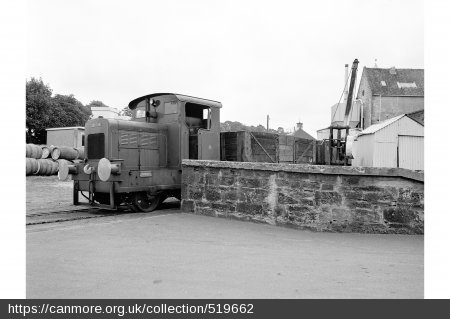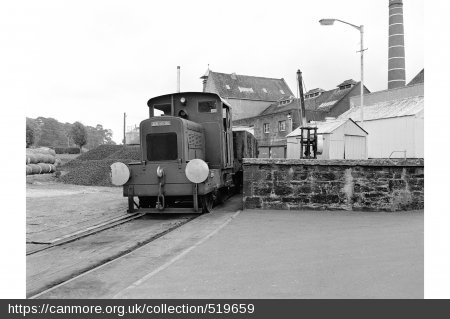NB. Please also refer to the excellent Great North of Scotland Railway Association article of August 2011, reproduced here with kind permission of the GNSRA - click to view PDF file.
"Queen Anne" is a Ruston Hornsby 48 DS diesel shunter, works number 265618 built in Lincoln in 1948. The prototype for this class was built in 1935 using a Lister engine and bought by Heinz Ltd. The design was developed over the following years and used the Ruston 4VRO engine. In 1946 the class was improved by the use of a Ruston 4VRHL engine developing 48 HP. Subsequent changes mainly involved the cab until the introduction of the 4YC engine from 1957. This design of shunter was one of the smallest standard gauge locos in Britain.
"Queen Anne" is a Ruston Hornsby 48 DS diesel shunter, works number 265618 built in Lincoln in 1948. The prototype for this class was built in 1935 using a Lister engine and bought by Heinz Ltd. The design was developed over the following years and used the Ruston 4VRO engine. In 1946 the class was improved by the use of a Ruston 4VRHL engine developing 48 HP. Subsequent changes mainly involved the cab until the introduction of the 4YC engine from 1957. This design of shunter was one of the smallest standard gauge locos in Britain.
Queen Anne was delivered new to Longmorn Distillery on 11th October 1948 and spent all its life there until it was donated to the Strathspey Railway in 1980.
 |
| Queen Anne at Longmorn in 1977 |
Longmorn lies about three miles south of Elgin on the GNSR line from Craigellachie to Elgin via Rothes (closed in 1969). There are three distilleries in this area, all built by John Duff. Glenlossie was built in 1876 and lies about one-and-a-half miles west. Longmorn was built in 1894 and Benriach, which lies adjacent to Longmorn, was built in 1898.
 |
| Another view of the distillery |
There was a boom in whisky distilling in the late 19th century which led to overproduction and the "Pattison Crash" of 1898. This led to many distilleries going bankrupt and being bought up at bargain prices by others. Longmorn and Benriach were bought by James Grant and Glenlossie by H.M.S. MacKay. MacKay built the siding from Glenlossie to the GNSR at Longmorn station and the Grants subsequently connected their distilleries too. Benriach ceased distilling after only a few years, but its maltings were used to supply the adjacent Longmorn distillery. Benriach was bought by a small independent company in 2004 and is now a highly successful distiller of quality Speyside malt whisky.
 |
| QA hauling open wagons and an aluminium-clad malt van |
 |
| A similar Aveling & Porter to Glenlossie - see below for copyright. |
The owners of Glenlossie severed their rail connection in 1956. Even after the main line at Longmorn closed in 1969, the small local rail network continued to be used by Longmorn and Benriach for the transfer of malt and casks between the various buildings on site. By 1979 the railway system was getting worn out and the owners, Chivas Bros., decided to close the system and donate everything to heritage railways. The track, the Ruston loco and two aluminium clad vans went to the Strathspey Railway and two 5-plank open wagons went to the Brechin Railway. It appears that although the railway system was superseded in 1979 by a tractor and trailer, it was not until 1980 that the rolling stock was dispersed, as a photograph exists of the locomotive in its original green livery with the distillery staff and barrels of Longmorn and Benriach whisky dated 1980.
Queen Anne had been delivered in 1948 painted in a Mid Green colour (a lighter shade than the usual "Deep Bronze Green" used by Ruston) with white lining and white buffers and a Ruston & Hornsby crest on the cab sides.
These two colour photographs show the green livery. They are taken from a similar position but the first shows trees in the background and must be much earlier. The second was taken shortly before the loco left for Aviemore in 1980.
Prior to donation it was repainted with advertisements for Queen Anne whisky, a premium blended whisky produced by the distillery at the time. The background was painted in a chocolate brown colour.
It seems that the background colour was repainted in a beige shade
after arrival at Aviemore, although the Queen Anne advertisements were
not altered.
After only a few years use at Aviemore, it was abandoned in a siding. There were rumours of gearbox problems or frost damage, but neither of these seem true. It was likely that other more powerful locomotives became available and superseded it.
 |
| Early photo in original green livery |
 |
| Photo taken in 1979 or 1980 |
These two colour photographs show the green livery. They are taken from a similar position but the first shows trees in the background and must be much earlier. The second was taken shortly before the loco left for Aviemore in 1980.
Prior to donation it was repainted with advertisements for Queen Anne whisky, a premium blended whisky produced by the distillery at the time. The background was painted in a chocolate brown colour.
 |
| The new and the old side-by-side |
 |
| Queen Anne leaving for Aviemore |
After only a few years use at Aviemore, it was abandoned in a siding. There were rumours of gearbox problems or frost damage, but neither of these seem true. It was likely that other more powerful locomotives became available and superseded it.
Much of the information in this article has been obtained from the book "Iron Rails and Whisky Trails" by Ian Philip Peaty (2013) and the article in "Great North Review" (Aug 2011).
Glenlossie photo by TruckinTim with Flickr Creative Commons Licence
Glenlossie photo by TruckinTim with Flickr Creative Commons Licence


No comments:
Post a Comment